Exploring the Relationship of the American School of Classical Studies at Athens with the Greek Omogeneia in the United States in the 1940s.
Posted: July 4, 2019 Filed under: Archaeology, Archival Research, Biography, History of Archaeology, Mediterranean Studies, Modern Greek History, Philhellenism | Tags: American School of Classical Studies at Athens, Greek War Relief Association, Nikolaos Mavris, Omogeneia, Oscar Broneer, Spyros Skouras, Theodore Leslie Shear, Triumph Over Time 7 CommentsIn 1947, the American School of Classical Studies at Athens (ASCSA or the School hereafter) produced a color movie titled Triumph over Time; it was directed by the archaeologist Oscar Broneer and produced by the numismatist Margaret E. Thompson with the aid of Spyros Skouras (1893-1971), the Greek American movie mogul and owner of Twentieth Century Fox (see Spyros Skouras Papers at Stanford University). Triumph over Time portrays Greece rebounding from World War II and the staff of the ASCSA preparing archaeological sites for presentation to postwar tourists. The film was made to promote the first postwar financial campaign of the ASCSA, the direct goal of which was to increase its capital and finance the continuation of the Athenian Agora Excavations. Indirectly, the ASCSA was hoping to contribute to the rehabilitation of Greece by providing employment for the Greek people and by promoting the economic self-sufficiency of Greece by developing the country’s tourist assets (Vogeikoff-Brogan 2007).

Oscar Broneer, ca. 1938. ASCSA Archives, Oscar Broneer Papers.
Triumph over Time begins with a brief overview of impressive Greek antiquities, such as the citadels of Mycenae and Tiryns and the Temple of Poseidon at Sounion, before continuing with rare ethnographic material capturing parts of rural Greece that no longer exist. It then moves from the Greek countryside to the buildings of the ASCSA, especially the Gennadius Library with its rare treasures. The story then covers the ASCSA’s two most important projects, the excavations at the Athenian Agora and at Ancient Corinth, explaining all stages of archaeological work. The documentary ends with a hopeful note that financial support of the ASCSA’s archaeological work will contribute to an increase in tourism so that this major source of revenue for Greece’s economy can “restore stability and well-being to this simple pastoral land.”

Stills from Triumph Over Time
All three contributors to the film had served in the Greek War Relief Association (GWRA) during and after World War II. The GWRA was incorporated in New York on November 8, 1940. Its founding members included Archbishop Athenagoras, Skouras, Van Nomikos, and other prominent Greek Americans, as well as Americans Harold Vanderbilt, Samuel Goldwyn, and Senator William King. In 1946, the GWRA together with the American Hellenic Educational and Progressive Association (AHEPA) had raised the unbelievable amount of five million dollars for the implementation of a medical and hospitalization program in postwar Greece (Saloutos 1964, p. 364).

Greek War Relief Association, letterhead. ASCSA Archives, Oscar Broneer Papers.
My research in the ASCSA Archives indicates that Broneer and Margaret Thompson (1911-1992) would not have undertaken the production of the film, in conjunction with the ASCSA’s fund-raising campaign, without relying on their previous experience at the GWRA and their relationship with Skouras. It is clear that, from the beginning, Broneer and Thompson planned to target the prosperous Greek American community, although not strictly limiting their efforts to this group. On May 23, 1947, Broneer wrote to Louis Lord, the chair of the ASCSA Managing Committee, echoing the feelings of the Greek omogeneia (people of Greek origin who immigrated to, or were born in, a foreign land) in America at the end of the first half of the 20th century:
“I have never thought of the campaign as restricted to the Greek population in America. As such it would be a failure from the start. What I had in mind was a campaign to interest the general public, and in such a campaign I feel certain that we would interest the Greek Americans. They are an exceedingly generous lot, but the more progressive among them resent being treated as a minority group. They like to think of themselves as Americans, without modification, and they would rally to the cause better if they felt that they were part of a general program to raise funds for archaeology in Greece” (ASCSA Archives, AdmRec 310/8).

Margaret Thompson and her niece wearing Greek attire, ca. 1948. Source: American Numismatic Society.
While reviewing the history of Triumph over Time, I became interested in the relationship that developed during World War II between the American archaeologists working in Greece and the Greek American community in the United States during World War II. Until then, there is no evidence that the leadership of the ASCSA ever sought or cultivated any ties with the Greek omogeneia. The ASCSA’s financial prosperity before World War II and the humble profile of the Greek immigrants in America probably explain the absence of any contact between the two parties (on the early history of the Greek omogeneia, see Laliotou 2004). My subsequent investigation of the ASCSA archival collections indicates that, during World War II, American archaeologists developed close contacts with influential members and organizations of the Greek American community and passionately supported the Greek cause. At the same time, the Greek Americans came to realize that American archaeologists working in Greece were among the strongest supporters of Greece in America.
The papers of Oscar Broneer, a professor of archaeology at the ASCSA and the executive vice president of the GWRA, and the papers of Nikolaos (Nicholas) Mavris (1899-1978), a doctor and a prominent member of the Greek American community and the first governor commissioner of the freed Dodecanese in 1948, allow us to explore the two-way relationship of the American archaeologists with the Greek omogeneia during the war, something that has gone unnoticed in the official history of the ASCSA.
THE AMERICAN SCHOOL COMMITTEE FOR AID TO GREECE

The American School Committee for Aid to Greece. Benefit concert, 1941. ASCSA Archives, Oscar Broneer Papers.
Oscar Broneer (1894-1992) had already lived for several years in Greece, digging on the North Slope of the Athenian Acropolis and at Corinth, and teaching at the ASCSA, before he and his family returned to the United States in 1939, just before the beginning of World War II. The Broneer family moved to Princeton to join other ASCSA members who worked and studied at the Institute for Advanced Study. Theodore Leslie Shear, Paul Clement, Benjamin Meritt, George Elderkin, Shirley Weber, and Edward Capps formed the core of a group that immediately mobilized after Italy declared war against Greece in October of 1940. Less than a month after the Italian invasion, the American archaeologists residing at Princeton had formed a committee, known as the ASCSA Committee for Aid to Greece, which raised considerable funds to support the people of Greece. The committee raised a total of about $27,000 through written appeals to ASCSA members and associates, the organization of two benefits, and royalties from the book This is Greece. Some of the funds were used to purchase “IASO,” a Red Cross ambulance (On the ASCSA Committee for Aid to Greece, Meritt 1984, pp. 7-8). Archaeologist Rodney Young, a staff member of the Agora Excavations, drove “IASO” to the Albanian war front. The rest of the funds were used to buy supplies for hospitals, canteens, and civil relief agencies in Greece. After January 8, 1942, the Committee was unable to deliver any more aid to the Greek people because of the food and supply boycott that the Allies imposed on all the German-held territories of Europe; the ASCSA Committee decided to cease functioning at this that time. Many of its members continued working towards for the relief of Greece through other agencies like such as the American Friends of Greece (AFG) and the GWRA.
OSCAR BRONEER AND HIS SERVICE AT THE GWRA
On August 12, 1942, Broneer was invited by the Greek American Progressive Association (GAPA) to deliver a talk about Greece in Pittsburgh, where he received very favorable comments from the event organizers. “All were impressed with your talk and were particularly pleased with your stressing the need for relief for the Greek people. . . . We consider both of you [Broneer and Meritt] as sincere Hellenists and interested in the welfare of Greek people,” wrote Theo Manos in his thank-you letter to Broneer. A little later, in November of 1942, the Trenton Chapter of AHEPA invited Broneer to join the organization:
“Knowing your feelings for Hellas and the knowledge that you always carry with you of Hellenic culture we the members of the Trenton Chapter #72 of the Order of AHEPA feel that our Chapter membership is not quite complete unless we can count you as one of our members” (ASCSA Archives, Oscar Broneer Papers).
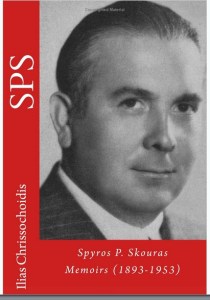
Ilias Chrissochoidis (ed.), Spyros P. Skouras: Memoirs (2013)
By December of 1942, Broneer was offering his services to the newly established organization of Foreign Relief and Rehabilitation Operations (OFFRO) run by the U.S. State Department, which hired him in May of 1943. Towards the end of the year, he received an invitation to attend a benefit dinner organized by the GWRA in New York on December 17th, 1943. This event proved to be very important for Broneer because it was here that he met Skouras, the owner of Fox Studios and the national president of the GWRA. Skouras immediately offered him work at the GWRA. Broneer was an attractive candidate, a Swedish-born American, fluent in Swedish and Greek, with impressive knowledge and firsthand experience of Greece. Skouras admired Broneer, who was already been actively involved in shipping food and supplies to Greece aboard Swedish ships (Sweden had remained neutral during World War II). By February of 1944, Broneer had accepted Skouras’s offer to work for the GWRA as executive vice president, a position that he held until 1946.
Not much is preserved in Broneer’s personal papers about his day-to-day activities at the GWRA. A lengthy entry in Broneer’s unpublished autobiography (“The Story of Per”), however, attests to the trusting relationship that he developed with Skouras:
“In April 1945, Spyros Skouras decided to make a trip to Greece to see for himself the condition of the country and the devastation wrought by four years of war and occupation. He wanted Per [Oscar Broneer] to accompany him. . . . Per and the three members of Spyros Skouras’ family wanted to make tours of inspection outside of Athens so as to see for themselves what the country had suffered and what was most needed, so that they could go back to the States and collect funds for the Greek War Relief Association. For the purpose Spyros Senior had brought with him a professional photographer from Twentieth Century Fox (ASCSA Archives, Oscar Broneer Papers, “The Story of Per,” p. 208).
Other information comes from contemporary newspapers. In August 1945 Broneer traveled extensively in the U.S. delivering speeches and showing films concerning the dramatic conditions in Greece after the close of the war in 1944. Press releases in American newspapers from August 1945 wrote about the Skouras/Broneer joint trip during which they visited “75 towns and villages during their four-week tour of Greece. In connection with his talks Mr. Broneer will show a 20-minute film entitled, ‘This Is Greece Today,’ which was taken during his tour” (The Rock Island Argus, August 3, 1945, p. 10). In Moline, Iowa, he was introduced to the audience by Charles Bookidis. I mention this because Charles was the father of archaeologist Nancy Bookidis, a long-time member of the ASCSA and assistant director emerita of the Corinth Excavations.
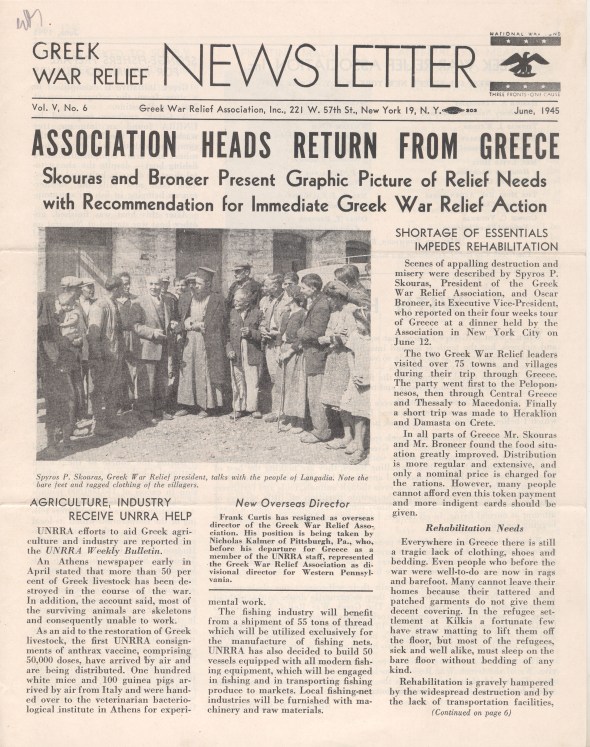
Greek War Relief’s Newsletter announcing the return of Spyros Skouras and Oscar Broneer from Greece, June 1945. ASCSA Archives, Oscar Broneer Papers.
In February 1946, Broneer delivered a two-part speech in Newport, Rhode Island, as a guest of the Art Association. The first part concerned his prewar excavations on the North Slope of the Athenian Acropolis; in the second half he described what he saw in his 1945 trip to Greece with Skouras: “A bareness noted in the landscape, he said, was due to the sacrifice of groves of trees for fuel. The people he described as worn, ragged, poor, but hopeful. A friend he met in Corinth had hidden a New Zealand soldier in a hole in his home through 73 searches by Germans, who had machine-gunned whole families of his neighbors for such offenses. A whole generation of children, he said, have never seen chocolate, and didn’t know what to do with the pieces they were given. Invariably, the children seem three or four years younger than they are because of retarded growth…”(Newport Mercury, 15 February 1946, p.8)
Another press release announcing his Broneer’s return to Greece, in July of 1946, praised him for his hard work toward the rehabilitation of Greece, his public speeches in support of Greece before American dignitaries, and his indefatigable travels to explain the relief program of the GWRA to Greek communities all over the United States. (When I first published this essay in 2008, I did not have access to the rich archive of Newspapers.com; my research was, therefore, limited to the few clippings that Broneer had saved in his papers. A recent search in Newspapers.com proved to be very enlightening concerning Broneer’s humanitarian efforts in the U.S. on behalf of the Greek cause.)
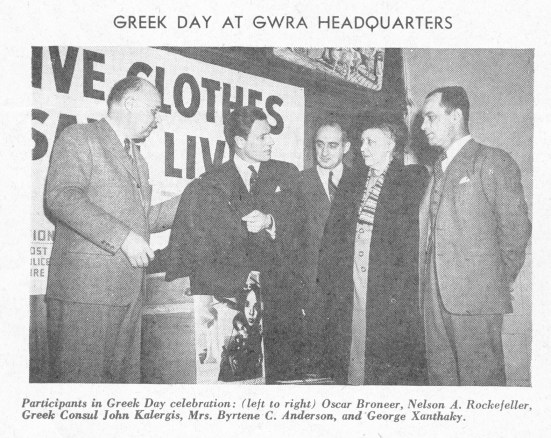
Celebrating Greek Day at the GWRA Headquarters, 1946. ASCSA Archives, Oscar Broneer Papers.
Having explored Broneer’s activities during the war years, I now return to the making of Triumph over Time. When Broneer agreed to initiate the ASCSA’s capital campaign soon after his appointment to the position of acting director for 1947-1948, he depended heavily on his close ties with the Greek American community. He also asked that Margaret Thompson assist him in the campaign. Broneer and Thompson’s plan was to organize their fund-raising drive under the sponsorship of the local societies of the Archaeological Institute of America (AIA), which in turn would cooperate with the local Greek American communities.

The reel of Triumph Over Time is housed at the ASCSA Archives. In 2007 it was digitized and reissued as a DVD.
The film was finally shown in thirteen American cities, but, despite the large audiences that attended the showings, it brought almost no financial gain to the ASCSA. There are many reasons for the failure of this attempt by the ASCSA to raise money. One has to do with Broneer personally. The death of his wife, Verna, in January of 1948, just before the beginning of the fund-raising drive, forced him to withdraw completely. Although other American archaeologists undertook the task of lecturing and showing the film across America, it must have felt like they were escorting an orphaned child. In my opinion, Triumph Over Time would have had a better chance if Broneer himself had remained behind the wheel, making use of his previous GWRA contacts.
The second reason has to do with the change in the political situation. By 1948, the American public, including Greek American communities, were exhausted from the financial strain of supporting the many fund-raising campaigns that various relief agencies had introduced since the outbreak of World War II. In addition, with the announcement of the Truman doctrine and the launch of the Marshall Plan in 1947, the American public felt that the rehabilitation of Greece and other European countries no longer depended on their individual philanthropy but was being taken care of centrally by their government.
Nevertheless, thanks to Broneer, Thompson, and Skouras, the ASCSA managed to produce a film of enduring value in 1947, one that serves as a vivid testimony to a love of Greece, both the land and its people, that still characterizes the work of the ASCSA today. (You can watch the 40 minute film here.)
THEODORE LESLIE SHEAR AND THE DODECANESIAN NATIONAL COUNCIL
The papers of Nicholas Mavris provide plenty of insight into the actions of another organization, the American Friends of Greece (AFG), and Theodore Leslie Shear (1880-1945), its vice chairman and director of the School’s excavations in the Athenian Agora (1931-1945).
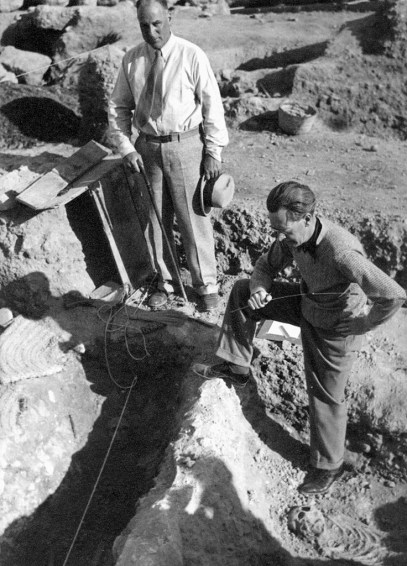
Theodore Leslie Shear and architect Piet de Jong, Agora Excavations 1935. ASCSA, Athenian Agora Excavations Archive.
Established by a group of American philhellenes in 1923, the AFG’s mission was to contribute to the strengthening of Greece after the Asia Minor catastrophe. During World War II, the AFG contributed enthusiastically to the relief of the Greek people through the GWRA. In order to avoid duplicating the work of other agencies interested in the rehabilitation of Greece, the AFG concentrated its efforts on educational institutions in Greece, through contributions to Athens College and Pierce College, the establishment of scholarships, publication of scientific studies, and the promotion of good cultural relations between America and Greece. The officers of the AFG included eminent members of the ASCSA, such as Edward Capps, George H. Chase, Theodore Leslie Shear, and W. Stuart Thompson. The ASCSA Archives preserves several issues of the organization’s bulletin, The Philhellene. In the Gennadius Library, one can find publications of the organization; e.g., Greece Fights, by Homer W. Davis, and Let Freedom Ring, which was issued on the occasion of a benefit dinner held in honor of the Greek people on March 25th, 1942.

The Philhellene. Bulletin of the American Friends of Greece, October-November 1942. ASCSA Archives, Peter Topping Papers.
In addition to its educational mission, the AFG became involved, through its vice chairman, in the liberation of the Dodecanesian Islands. In an editorial essay in the October-December 1943 issue of The Philhellene, Shear boldly expressed his support for the Dodecanesian cause:
“Let the injustice of the past thirty years be expiated by immediate delivery of the Islands to Greece as soon as they are liberated! Let not the Dodecanese continue to be an apple of discord in the Eastern Mediterranean.”
The editorial essay had been preceded by an exchange of letters between Shear and Mavris, the president of the Dodecanesian National Council. The letters show that Shear was considered a staunch supporter of the Dodecanesian issue, and that the Dodecanesian Council frequently sought and accepted his advice on how to proceed. In fact, in the board of directors meeting of the Dodecanesian Council on September 15, 1943, Shear was unanimously elected an honorary member of the Council.
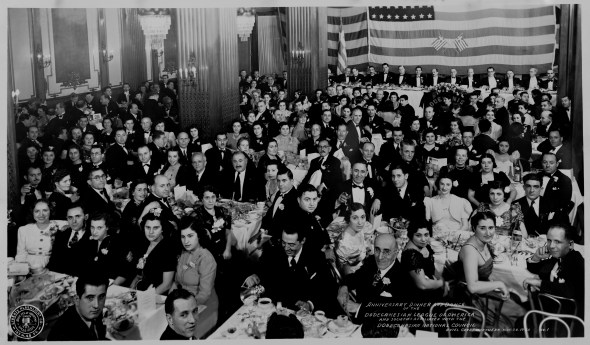
Anniversary dinner and dance of the Dodecanesian League of America and societies affiliated with the Dodecanesian National Council, 1940. ASCSA Archives, Nicholas Mavris Papers.
Theodore Leslie Shear went as so far as to write a personal letter to Senator Claude Pepper (1900-1989) expressing his utmost gratitude for Pepper’s action in introducing “the resolution on August 8th declaring that the islands are and of right ought to be part of the Greek realm” (August 12, 1944). Shear also urged “all Greek organizations and as many individuals to write letters to their own Senators demanding action on the resolution, which, otherwise, may die in Committee” (September. 29, 1944). In April of 1945 and in anticipation of the Peace Conference, Shear was worried that the Greeks might not get a world hearing unless all Greek organizations swamped the conference with their demands for justice; otherwise, he saw a risk of Greece remaining “a crown colony of England indefinitely.” What Shear had hoped and wished for the Dodecanese finally happened a year later, in 1946, when the American U.S. Senate Committee on Foreign Relations unanimously adopted Pepper’s resolution asking that the Dodecanese be awarded to Greece (Saloutos 1964, p. 366). Unfortunately, Shear had passed away in July 1945.
AFTERTHOUGHTS
I would like to conclude this essay by noting that the contribution of the ASCSA members during World War II towards the relief and the rehabilitation of Greece requires further exploration. The second volume of the History of the American School refers to the heroic efforts of those of its members who remained in Greece during the war, men such as Bert H. Hill, Gorham P. Stevens, Rodney Young, and the Vanderpools (Meritt 1984, pp. 6-38). From the ones who returned home, several (e.g., Carl Blegen, John Caskey, Dorothy Cox, Alison Frantz, Virginia Grace, and Jerome Sperling) offered their unique knowledge of topography and languages to the Office of Strategic Services, a subject that Susan H. Allen has investigated (Allen 2011); others, such as Oscar Broneer, George Chase, Antony Raubitscheck, Theodore L. Shear, Margaret Thompson, and Mary Zelia Philippides (to name a few) followed a different trajectory by reaching out to the Greek omogeneia, either by being involved in various relief efforts or using their established philhellenism as a vehicle to promote aspects of the Greek cause in America.
Did these newly formed postwar ties between the School and the omogeneia remain strong over the years or eventually fade? I am inclined to say that they laid dormant for several decades. Spyros Skouras would become the first ASCSA trustee of Greek descent in 1947, but more than twenty years would pass, before the next trustee of Greek descent was elected in 1969 (Thomas A. Pappas, trustee 1969-1982; Meritt 1984, p. 277). It was only after the 1990s that the School pursued with zeal a renewal of its ties with the Greek omogeneia: as a result, more than a dozen Greek Americans are serving today on the School’s Board of Trustees and on the Board of Overseers of the Gennadius Library.
NOTE
I first published this essay in The Archaeology of Xenitia: Greek Immigration and Material Culture, ed. K. Kourelis, The New Griffon 10, Athens 2008, pp. 41-47. Since it has been out of print for years, I decided to revise and republish it here, by adding new information and more photographic documentation, thus making it accessible to a larger audience.
REFERENCES
Allen, S.H. 2011. Classical Spies: American Archaeologists with the OSS in World War II Greece, Ann Arbor.
Laliotou, I. 2004. Transatlantic Subjects: Acts of Migration and Cultures of Transnationalism Between Greece and America, Chicago.
Meritt, L. S. 1984. A History of the American School of Classical Studies at Athens, 1939-1980, Princeton.
Saloutos, Th. 1964. The Greeks in the United States, Cambridge, Mass.
Vogeikoff-Brogan, N. 2007. Triumph over Time: The American School of Classical Studies at Athens in Post-War Greece, Princeton.


Good stuff, Natalia. Keep it coming. Glenn
Thank you Glenn.
So glad this is now available for all to read because it was an amazing piece!!! K
On Thu, Jul 4, 2019 at 1:55 PM From the Archivist’s Notebook wrote:
> Natalia Vogeikoff-Brogan posted: “In 1947, the American School of > Classical Studies at Athens (ASCSA or the School hereafter) produced a > color movie titled Triumph over Time; it was directed by the archaeologist > Oscar Broneer and produced by the numismatist Margaret E. Thompson with the > a” >
And you organized a great conference back in 2008 at the AIA Meetings (Chicago), the reason for the existence of this essay.
AHEPA Cornerstone Laying April 1947 Evangelismos Hospital attendance
Thank you Mr. Petros. Is there a photo? Best, Natalia Vogeikoff-Brogan
Congratulations on your good work!